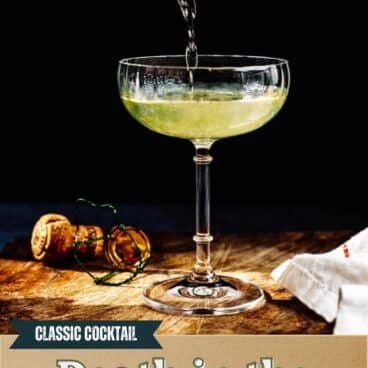This post may include affiliate links; see our disclosure policy.
Death in the Afternoon is a must-try absinthe cocktail invented by Ernest Hemingway! This easy drink is bubbly with a black licorice finish.

If you’re a cocktail connoisseur, you likely have a bottle of absinthe around. Here’s one of the most fun ways to use it: the Death in the Afternoon cocktail! This iridescent green cocktail stars the combination of absinthe and sparkling wine, and the flavor is delightful: bubbly with that classic black licorice finish.
Invented by Ernest Hemingway himself, it’s a unique drink to pull out to impress guests. Of course, we like it so much we don’t mind sipping on it as a nightcap, either!
Ingredients in the Death in Afternoon cocktail
Death in the Afternoon is a cocktail made with absinthe and champagne invented by the writer Ernest Hemingway. The name comes from his book, Death in the Afternoon, and was first published in a cocktail book in 1935. A key feature of this cocktail its cloudy color. In fact, in the original recipe Hemingway states to “add iced Champagne until it attains the proper opalescent milkiness.” This drink is sometimes called a Hemingway cocktail or Hemingway champagne.
The original Death in the Afternoon cocktail was made with just absinthe and champagne, but over the years it was customary to add some simple syrup. We found it needs just a bit of sweetness to make it palatable. The recipe below has the best ratio of all the ingredients for maximum drinkability and intrigue. The ingredients you need for a Death in the Afternoon are:
- 1 oz absinthe
- 4 oz champagne or Prosecco
- 1 teaspoon simple syrup

What you need to know about absinthe
As you may know, absinthe is quite the controversial liquor. In fact, it was illegal in the US for almost 100 years! It was so iconic that famous painters even depicted it in their paintings (like Picasso). But don’t worry: scientists of today have determined that absinthe is perfectly safe consumed in moderation! Here’s what to know before grabbing a bottle of absinthe:
- Absinthe is a green anise-flavored spirit made from botanicals: wormwood, anise, fennel and other herbs. It has an herbal flavor and a strong black licorice finish. It was illegal in the US from 1912 to 2007.
- Is absinthe hallucinogenic? No! But this is why it was illegal in Europe and the US for almost 100 years. It became popular in the 1840s, but started to be associated with violent crimes. While that wasn’t true, people worked to have absinthe banned. Modern research has confirmed absinthe is no more harmful than any other alcohol!
- Is it worth buying? Yes, if you’re an adventurous cocktail drinker! Absinthe features in several classic cocktails: the Sazerac, La Louisiane, and Corpse Reviver.
- Don’t have absinthe? Pastis or Pernod make a good substitute.

Use any sparkling wine
When the Death in the Afternoon cocktail was invented, champagne was the easiest option to access for this cocktail. Since then, lots of different regional sparkling wines have risen to popularity. In particular, we love Prosecco because it’s cheaper to buy a high quality bottle and it has great flavor. Here are a few notes on the differences between sparkling wines:
- Champagne: French sparkling wine. It’s bubbly and fruity, with undertones of almond and orange. It’s typically the most expensive sparkling wine.
- Prosecco: Italian sparkling wine. It’s a little sweeter than champagne and has lighter bubbles. It’s fruity and flowery, with notes of apple, pear and lemon.
- Cava: Spanish sparkling wine. It has more citrus notes, and is a little more savory and less fruity.

Death in the Afternoon is cloudy (and a tip to make it bubbly)
Here’s one thing to note about the Death in the Afternoon: though it stars champagne, it’s not bubbly! When you combine champagne with another liquid, it kills the bubbles.
- It bubbles right when the champagne hits the absinthe, but then subsides. When the two liquids mix, they form an emulsion. You’ll notice a milky, effervescent green color.
- Want it to bubble? Add a sugar cube instead. If you really love bubbly drinks, skip the simple syrup and add a sugar cube. It makes a bubble fountain just like the classic Champagne Cocktail. But the classic way to serve this drink is cloudy.
Death in the Afternoon
Death in the Afternoon is a must-try absinthe cocktail credited to Ernest Hemingway! This easy drink is bubbly with a black licorice finish.
- Prep Time: 2 minutes
- Cook Time: 0 minutes
- Total Time: 2 minutes
- Yield: 1 drink 1x
- Category: Drink
- Method: Poured
- Cuisine: Cocktails
- Diet: Vegan
Ingredients
- 1 ounce (2 tablespoons) absinthe
- 1 teaspoon simple syrup
- 4 ounces (½ cup) Champagne or Prosecco
Instructions
- Pour the absinthe and simple syrup into a cocktail glass. Top it off with the sparkling wine.
More absinthe cocktails
The Death in the Afternoon cocktail is a classy champagne cocktail that’s unique and impressive. Absinthe stars in many classic cocktails: so it’s absolutely worth having on hand! Here are the most famous absinthe cocktails:
- Try the Corpse Reviver, a classic sour cocktail with gin and lemon
- Mix up a Sazerac, the official drink of New Orleans
- Opt for the La Louisiane, another boozy New Orleans cocktail






Perfect recipe write
Hi,
Where did you get these great coupe glasses?
They are from Crate & Barrel: https://rstyle.me/+6Tcihv67cFbe8rzgLZAUDQ
Love that cocktail!